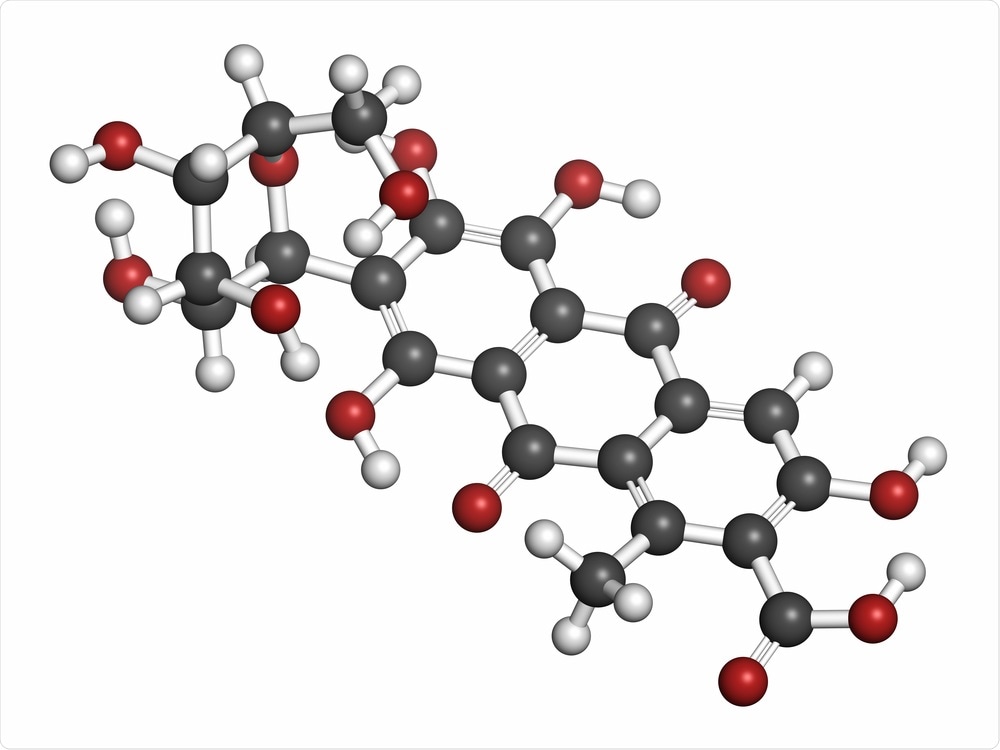Carminic acid (a natural red dye extracted from insects) is extensively used in the cosmetic, pharmaceutical, and food industries globally. However, the breakdown of carminic acid naturally is yet unclear. Japanese researchers recently employed a combination of biochemical and structural analyses to shed light on this puzzle.

Image Credit: StudioMolekuul/Shutterstock.com
A group of researchers headed by the University of Tsukuba identified a soil microorganism harboring an enzyme that starts the initial step in the breakdown of carminic acid. The research was published on October 5th, 2021, in the Proceedings of the National Academy of Sciences.
Carminic acid is produced by cochineal scale insects, parasites of Cacti. Carminic acid is a natural C‑glycoside—an exceptional compound where sugar is attached to a non-sugar (or aglycone) molecular group via a carbon-carbon bond.
Even though enzymes are observed earlier in intestinal microorganisms that start the breakdown of C‑glycosides, the specifics of its occurrence are not completely known to date. The scientists intended to clarify the enzyme structure and mechanistic pathway.
Carminic acid is very important as a natural ‘red dye’ all over the world, but its metabolic pathway in nature has never been identified. We screened and isolated a carminic acid–catabolizing microorganism from soil samples and found a flavin adenine dinucleotide (FAD) dependent enzyme, that we termed CarA, that catalyzes the first step of C‑glycoside–metabolism by oxidizing the C3 position of the sugar moiety.”
Professor Michihiko Kobayashi, Study Senior Author and Professor, University of Tsukuba
The scientists gathered soil samples from around the University of Tsukuba and isolated microbes that can grow on an agar plate with carminic acid alone as the carbon source. The researchers concentrated on a single bacterial strain—5‑2b—as the red coloring from carminic acid vanished around colonies from this particular bacterial strain, strongly indicating the degradation of the natural red dye.
Intriguingly, an equivalent overall pathway for the breakdown of carminic acid was shown for both soil and intestinal microbes, the enzyme speeding up the first step was completely different between the two strains.
Our investigations suggest that the differences in the carminic acid metabolizing enzyme between soil and intestinal bacteria possibly arise from the adaptation to aerobic and anaerobic environments, respectively, because CarA needs oxygen for its enzymatic activity.”
Takuto Kumano, Study Lead Author and Professor, University of Tsukuba
Moreover, the researchers identified that CarA can initiate the breakdown of certain other kinds of glycosides too, although not as well as for carminic acid.
Our findings now provide insight into the previously unknown biogeochemical circulation of carminic acid and C‑glycosides in nature. Now that we have a crystal structure of a homolog of CarA, the next essential step is obtaining a structure that contains a substrate.”
Michihiko Kobayashi, Study Senior Author and Professor, University of Tsukuba
Source:
Journal reference:
Kumano, T., et al. (2021) FAD-dependent C-glycoside–metabolizing enzymes in microorganisms: Screening, characterization, and crystal structure analysis. Proceedings of the National Academy of Sciences. doi.org/10.1073/pnas.2106580118.